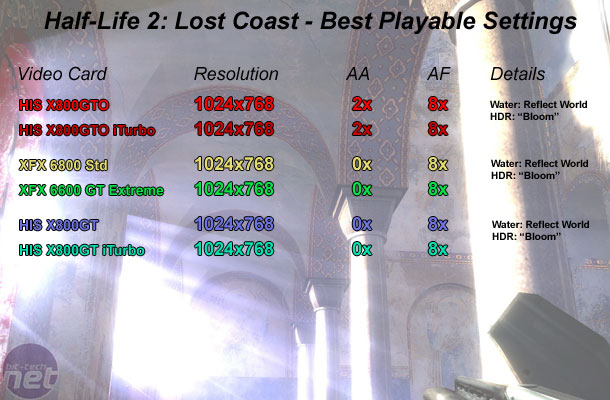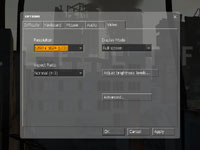Half-Life 2: Lost Coast
Publisher: ValveWe used the upcoming Valve Source engine technology demo that demonstrates Valve's implementation of high-dynamic range rendering in to its engine. The game is not currently available on Steam, but will be soon - we're using the stand alone version for beta testing. We did a manual run through of the whole map, seeing as there is no part that really stands out as being ideal for a manual run through. In total, the game play lasts around 8 to 10 minutes.
Anti-Aliasing and Anisotropic Filtering were controlled from inside the game, and thus the drivers were left set to "Application Controlled". There are three options for the method of HDR used in this title. You can either disable HDR completely, make use of "Bloom" which is just what it says and less resource hungry in comparison to "Full" which, again is just what it says. It utilises a full dynamic range with the iris effect too.
We have written quite a bit about Half-Life 2: Lost Coast and how Valve have implemented HDR. You can check out the articles listed below for more information on The Lost Coast.
- Half-Life 2: Lost Coast HDR overview
- Half-Life 2: Lost Coast hands on
- Half-Life 2: Lost Coast Benchmarks & Video
Below is a table of the best-playable settings that we found best for each video card configuration. We found that 20 to 25 frames per second minimum and a target of 45 frames per second (or higher) to be the average frame rate in our manual run through.

We found that the HIS Radeon X800GTO was the fastest card in this game - we were able to play the full level smoothly at 1024x768 2xAA 8xAF with water detail set to reflect world and high dynamic range set to "bloom". When we enabled the iTurbo mode, we found that we were not able to increase the in game detail, or even increase the resolution for that matter. However, we did find that the level was a lot smoother than it was when the card was operating at its default clock speeds.
The XFX GeForce 6800 Std and 6600 GT Extreme Gamer were pretty close together in terms of performance, with the Extreme Gamer having the slight advantage of both minimum and average frame rates. However, the differences were no more than a single frame per second in both cases and we found that the game was as smooth on our 6600 GT Extreme Gamer as it was on the 6800 Std.
Finally, the HIS X800GT did not really benefit from the iTurbo clock frequency enhancement either. The average frame rate was slightly lower than what we experienced on the 6600 GT and 6800 Std, but the minimum frame rate was exactly the same. We feel that it is reasonably safe to say that the gaming experience delivered by the HIS X800GT, XFX 6600 GT Extreme Gamer and 6800 Std is almost the same and you would be pushed to see the difference throughout the course of this level.

MSI MPG Velox 100R Chassis Review
October 14 2021 | 15:04








Want to comment? Please log in.